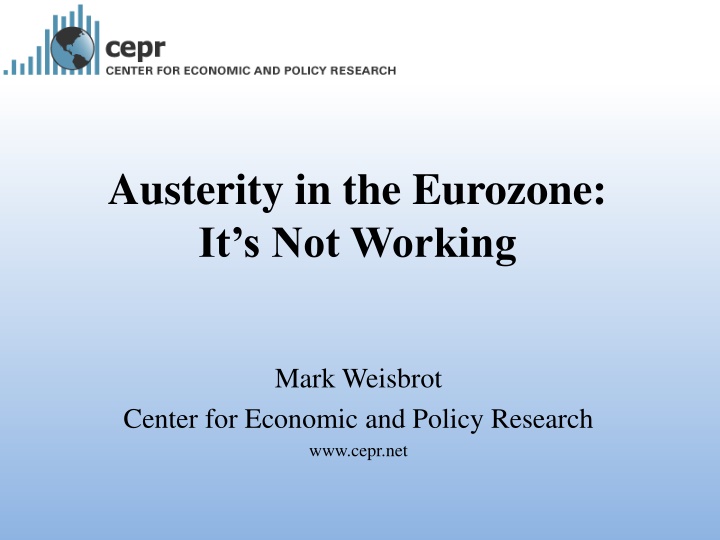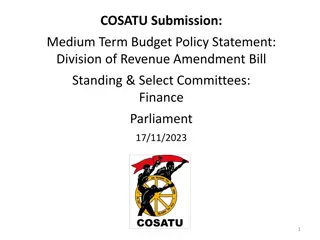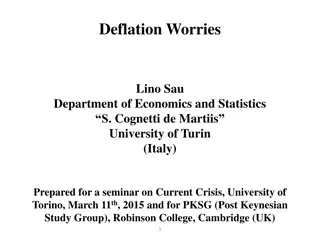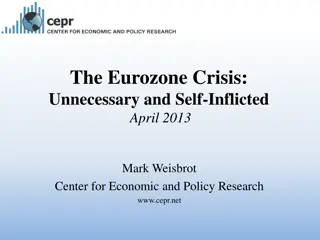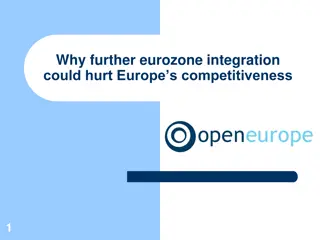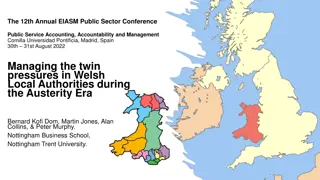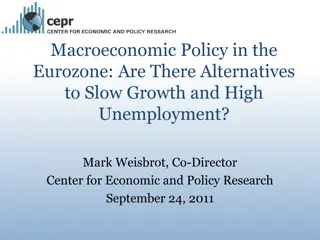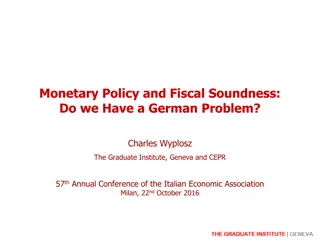Impact of Austerity Measures in the Eurozone: A Case Study of Greece
The article discusses the impact of austerity measures in the Eurozone, focusing on Greece as a case study. It highlights the challenges faced due to pro-cyclical fiscal policies, significant economic and social costs incurred, including a drastic reduction in GDP, soaring unemployment rates, and alarming social consequences such as increased suicides and violence. The data presented reveals the failure of austerity policies to revive the Greek economy, emphasizing the need for alternative approaches to promote sustainable growth and social well-being.
Download Presentation

Please find below an Image/Link to download the presentation.
The content on the website is provided AS IS for your information and personal use only. It may not be sold, licensed, or shared on other websites without obtaining consent from the author.If you encounter any issues during the download, it is possible that the publisher has removed the file from their server.
You are allowed to download the files provided on this website for personal or commercial use, subject to the condition that they are used lawfully. All files are the property of their respective owners.
The content on the website is provided AS IS for your information and personal use only. It may not be sold, licensed, or shared on other websites without obtaining consent from the author.
E N D
Presentation Transcript
Austerity in the Eurozone: It s Not Working Mark Weisbrot Center for Economic and Policy Research www.cepr.net
Most important Problem: Fiscal policy is pro-cyclical 2010-2011: Greece adopts measures to cut spending by 8.7 percent of GDP (For comparison: $1.3 trillion in the U.S.) As the economy shrinks, it becomes harder to make the revenue targets IMF has been way off in its projections and getting worse:
Greece: Real GDP Projections 185 180 175 billions of 2005 constant euros 170 165 160 1st Review 3rd Review 5th Review 2nd Review 4th Review Actual 155 150 2005 2006 2007 2008 2009 2010 2011 2012 2013 2014 2015 2016 Source: IMF (various) and Hellenic Statistical Authority
Greece: Unemployment Rate Projections 25 20 percent of total workforce 15 10 5 1st Review 3rd Review 5th Review 2nd Review 4th Review Actual 0 2005 2006 2007 2008 2009 2010 2011 2012 2013 2014 2015 2016 Source: IMF (various) and Hellenic Statistical Authority
Economic costs so far: Loss of 15.8 percent of GDP (among worst of past century s financial crises) 20.9 percent unemployment (Nov.); still more than 17 percent by 2016 (IMF) Minimum wage cut 20 percent (32 for those under 25) Mass layoffs (150,000 public workers by 2015) Cuts to health and education
Social costs: Kentikelenis et al. 2011. The Lancet: Suicides rose by 17% in 2009 from 2007 and unofficial 2010 data quoted in parliament mention a 25% rise compared with 2009. The Minister of Health reported a 40% rise in the first half of 2011 compared with the same period in 2010 [ ] Violence has also risen, and homicide and theft rates nearly doubled between 2007 and 2009. 52 percent increase in HIV 2010-2011.
Greece Employment as a Percent of Working Age Population 50 49 48 47 46 45 44 43 42 41 40 1994 1995 1996 1997 1998 1999 2000 2001 2002 2003 2004 2005 2006 2007 2008 2009 2010 2011 Source: Eurostat
Strategy Internal Devaluation Not Working Real effective exchange rate still higher than in 2006
Greece: Real Effective Exchange Rate 112 REER Deflated by CPI 110 REER Deflated by ULC 108 Index:2000=100 106 104 102 100 98 96 Source: Eurostat
Greece: Debt as a Percent of GDP Scenarios 180 170 160 150 140 Haircut on Private Debt 130 120 110 100 2009 2010 2011 2012 2013 2014 2015 2016 2017 2018 2019 2020 Source: IMF (various) and Weisbrot and Montecino (2012)
EU Net Interest Burden (Percent of GDP) 8 6 4 percent of GDP Luxembourg 2 Sweden Norway Finland 0 Poland Spain Italy France Cyprus Hungary Greece Portugal Malta Germany Ireland Slovakia Slovenia Denmark Estonia Lithuania Latvia Euro area Romania Czech Republic Bulgaria Belgium Austria Netherlands United Kingdom -2 -4 Source: IMF and Eurostat
Alternatives ECB, European authorities could reverse course and allow for expansionary fiscal policy in Greece and Eurozone but won t
Default and Exit: Argentina Banking system collapsed, but only one quarter of continued recession Then growth: 63 percent in six years Recovers pre-crisis GDP within 3 years Allow 2/3 reduction in poverty and extreme poverty Large increases in social spending, reduced inequality Huge Success
Argentina vs. Greece Comparative GDP Recovery Paths: Argentina (1996-2007) vs. Greece (2005-2016) 1996 1997 1998 1999 2000 2001 2002 2003 2004 2005 2006 2007 130 Argentina Historical Trend 125 120 115 Index: peak GDP = 100 Greece Historical Trend 110 105 100 95 90 85 80 2005 2006 2007 2008 2009 2010 2011 2012 2013 2014 2015 2016 Source: Weisbrot and Montecino (2012)
Argentine Recovery Misunderstood Not a commodities boom Not even export led Led by domestic consumption and investment Change in macroeconomic policy was key: change from pro-cyclical to pro-growth
Greek advantages over Argentina Export sector twice as big More potential sources of borrowing, if needed More developed economy, banking system
Outlook for Greece Sizeable probability of default/exit on current path Much more pain and slow recovery projected, at best Default/exit, if done right, could bring much faster recovery after initial crisis A responsible government should consider this option seriously
Eurozone in Recession The balance of risks to Europe s near-term growth remains to the downside a renewed escalation of the euro crisis remains a possibility so long as the underlying issues are not resolved. -IMF WEO April 2012
European Outlook Source: IMF WEO (Spring 2012)
Euro Area Annualized Quarterly Growth (2005 Constant Seasonally Adjusted Euros) 9 6 3.6 2.9 Percent Change 3 1.7 1.7 1.3 0.6 0.6 0 -1.2 -3 -6 2010Q1 2010Q2 2010Q3 2010Q4 2011Q1 2011Q2 2011Q3 2011Q4 Source: Eurostat
Germany Annualized Quarterly Growth (2005 Constant Seasonally Adjusted Euros) 9 8.0 6 5.5 3.2 Percent Change 3 2.3 2.1 1.9 1.1 0 -0.7 -3 -6 2010Q1 2010Q2 2010Q3 2010Q4 2011Q1 2011Q2 2011Q3 2011Q4 Source: Eurostat
France Annualized Quarterly Growth (2005 Constant Seasonally Adjusted Euros) 9 6 3.5 Percent Change 3 2.1 1.8 1.7 1.3 0.6 0.2 0 -0.1 -3 -6 2010Q1 2010Q2 2010Q3 2010Q4 2011Q1 2011Q2 2011Q3 2011Q4 Source: Eurostat
Netherlands Annualized Quarterly Growth (2005 Constant Seasonally Adjusted Euros) 9 6 3.1 2.8 Percent Change 3 2.2 1.9 0.7 0.6 0 -1.7 -2.5 -3 -6 2010Q1 2010Q2 2010Q3 2010Q4 2011Q1 2011Q2 2011Q3 2011Q4 Source: Eurostat
Ireland Annualized Quarterly Growth (2005 Constant Seasonally Adjusted Euros) 9 6 5.2 4.6 4.6 Percent Change 3 2.2 0 -0.8 -3 -2.8 -4.0 -4.2 -6 2010Q1 2010Q2 2010Q3 2010Q4 2011Q1 2011Q2 2011Q3 2011Q4 Source: Eurostat
Portugal Annualized Quarterly Growth (2005 Constant Seasonally Adjusted Euros) 9 6 3.5 Percent Change 3 1.1 0.8 0 -1.1 -1.6 -2.5 -3 -2.6 -5.0 -6 2010Q1 2010Q2 2010Q3 2010Q4 2011Q1 2011Q2 2011Q3 2011Q4 Source: Eurostat
Italy Annualized Quarterly Growth (2005 Constant Seasonally Adjusted Euros) 9 6 4.5 Percent Change 3 2.1 1.6 1.2 0.7 0.5 0 -0.7 -3 -2.6 -6 2010Q1 2010Q2 2010Q3 2010Q4 2011Q1 2011Q2 2011Q3 2011Q4 Source: Eurostat
Spain Annualized Quarterly Growth (2005 Constant Seasonally Adjusted Euros) 9 6 Percent Change 3 1.5 1.0 0.9 0.7 0.6 0.3 0.2 0 -1.2 -3 -6 2010Q1 2010Q2 2010Q3 2010Q4 2011Q1 2011Q2 2011Q3 2011Q4 Source: Eurostat
Greece: Unemployment Rate (Projections Start in 2012) 25 20 Percent of Labor Force 15 10 5 Projections 0 2001 2003 2005 2007 2009 2011 2013 2015 2017 Source: IMF WEO
Ireland: Unemployment Rate (Projections Start in 2012) 25 20 Percent of Labor Force 15 10 5 Projections 0 2001 2003 2005 2007 2009 2011 2013 2015 2017 Source: IMF WEO
Portugal: Unemployment Rate (Projections Start in 2012) 25 20 Percent of Labor Force 15 10 5 Projections 0 2001 2003 2005 2007 2009 2011 2013 2015 2017 Source: IMF WEO
Spain: Unemployment Rate (Projections Start in 2012) 25 20 Percent of Labor Force 15 10 5 Projections 0 2001 2003 2005 2007 2009 2011 2013 2015 2017 Source: IMF WEO
Change in REER: 2006Q1-2011Q3 (Deflated by Consumer Price Index and Unit Labor Costs) 10 CPI-based 8 ULC-based 6 Netherlands 4 France Germany Portugal Ireland 2 Percent Change 0 Italy Greece Austria -2 Spain -4 -6 -8 -10 -12 Source: Eurostat
Spain: National Accounts Contributions to Growth (2005 Constant Euros) 8 Stat. Discrepancy Gross Capital Formation Private Consumption Net Exports Public Consumption Real Growth 6 4 Percentage Points 2 0 -2 -4 -6 -8 2005 2006 2007 2008 2009 2010 2011 2012(f) Source: Eurostat and Ministry of Finance Spain
Spain: National Accounts Contributions to Growth (2005 Constant Euros) 8 Stat. Discrepancy Gross Capital Formation Private Consumption Net Exports Public Consumption Real Growth 6 4 Percentage Points 2 0 -2 -4 Planned Gov. Cuts -6 -8 2005 2006 2007 2008 2009 2010 2011 2012(f) Source: Eurostat and Ministry of Finance Spain
Youth Unemployment (Percent of Labor Force Under 25) 60 Greece 50 Spain Percent of Labor Force Under 25 40 30 20 Portugal Ireland 10 0 2007M01 2007M05 2007M09 2008M01 2008M05 2008M09 2009M01 2009M05 2009M09 2010M01 2010M05 2010M09 2011M01 2011M05 2011M09 2012M01 Source: Eurostat
EU Net Interest Burden (Percent of GDP) 8 6 4 percent of GDP Luxembourg 2 Sweden Norway Finland 0 Poland Spain Italy France Cyprus Hungary Greece Portugal Malta Germany Ireland Slovakia Slovenia Denmark Estonia Lithuania Latvia Euro area Romania Czech Republic Bulgaria Belgium Austria Netherlands United Kingdom -2 -4 Source: IMF and Eurostat
Alternatives Interest burden is what matters most ECB can keep that from growing
Fiscal Tightening Ireland: Spending cut by 6.5 billion between 2008-2011 (3.6 percent of 2008 GDP or 4.2 percent of 2011 GDP) France: Sarkozy pledges balanced budget by 2016 (deficit currently 5.3 percent of GDP) Spain: 27 billion in cuts from 2012 budget (2.3 percent of GDP in one year)
Conclusion Europe s crisis is not a debt crisis but a crisis caused by bad policy It has slowed world growth significantly and could do so again Feasible alternatives are available: ECB especially can end the crisis with bond purchases but refuses to do so Individual countries should consider other options, including exit may be less costly
